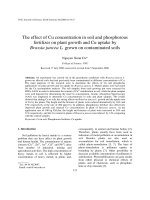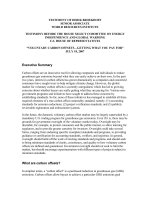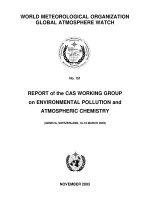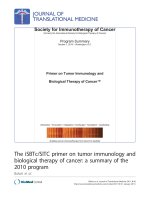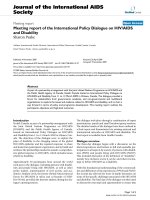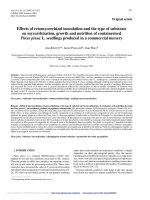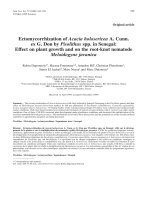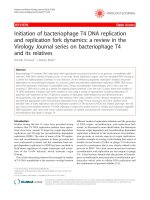Transgenerational effects of the plasticizer di-2-ethylhexyl phthalate on survival, growth, and reproduction of Daphnia magna
Bạn đang xem bản rút gọn của tài liệu. Xem và tải ngay bản đầy đủ của tài liệu tại đây (1019.58 KB, 6 trang )
Environmental Sciences | Ecology
Doi: 10.31276/VJSTE.61(4).64-69
Transgenerational effects of the plasticizer
di-2-ethylhexyl phthalate on survival, growth,
and reproduction of Daphnia magna
Thi-Phuong-Dung Le1*, Van-Tai Nguyen1, Thi-My-Chi Vo1, Nghia-Hiep Bui2, Thanh-Son Dao1
University of Technology, Vietnam National University, Ho Chi Minh city
2
Department of Environmental Engineering, Dayeh University, Taiwan
1
Received 6 September 2019; accepted 21 November 2019
Abstract:
In this study, we conducted a chronic toxicity assessment of di-2-ethylhexyl phthalate (DEHP) on the life history
traits of Daphnia magna across three generations. In the first generation, the neonates (called F0 Daphnia) were
raised in a control environment (C, toxin-free medium) or in a medium containing DEHP at three concentrations
5, 50, and 500 µgl-1, abbreviated as P5, P50, and P500, respectively. The offspring from the F0 control (called F1
Daphnia) were raised in toxin-free medium (denoted as C-C). However, the offspring from the P500 exposure
were split into two groups: (i) the first group was raised in a toxin-free, control medium (denoted as P-C) and (ii)
the second group was raised again in a medium containing 500 µgl-1 DEHP (denoted as P-P). The offspring from
the F1 (called F2 Daphnia) were split again and treated in the same manner as F1, resulting in C-C-C, P-P-C, and
P-P-P. The exposure time for each generation (F0, F1, F2) was 21 days. The survival and reproduction of D. magna
over the three generations (F0, F1 and F2) were recorded daily during the 21 days of incubation. The body length
of the animals in the F0 was measured by the end of incubation. The results showed that the survival rate of D.
magna in the control and DEHP treatments was similar, while the DEHP strongly enhanced the reproduction of
D. magna in the F0 and F1 generations. However, in the F2 generation, the survival rate for P-P-C and P-P-P was
only 45-50% compared to the control. Consequently a much lower accumulative neonate proportion in DEHP
treatment was found, around 50% compared to the control. The reduction in survivorship and reproduction of D.
magna in the F2 generation and the smaller body length of the P500 treatment is a consequence of energy cost and
trade-off under the chronic effects of DHEP. The results revealed that the population development of the microcrustacean may lead to an extinction upon continuous exposure to high phthalate concentrations in natural water
bodies. In situ monitoring on phthalates and zooplankton in aquatic ecosystems is suggested.
Keywords: chronic effects, life traits, micro-crustacean, plastic additives.
Classification number: 5.1
Introduction
Global production of plastic materials has increased
twenty-fold over the last fifty years, exceeding 300 million
tonnes in 2015 [1]. Worldwide, a great amount of plastic
waste is left unmanaged [2] and, more seriously, less than
5% of discarded plastic materials has been recovered [3].
Consequently, the continuous increase of plastic use over
time has negative effects on the environment, especially
water bodies. Plastics are known to contain a great number
of additives, e.g., bisphenol A and phthalates, among others.
Phthalates and their isoforms are among the most commonly
used solvents in various industrial and consumer products,
and the global production of phthalates is estimated to be
between 6 and 8 million tons annually [4]. The existence of
phthalates in the environment has been reported by many
countries such as Finland, Denmark, Germany, Japan, China,
Thailand, Poland, Sweden, and Italy [5]. While bisphenol
A is known as both an oestrogen agonist and an androgen
antagonist, impacting both reproduction and development
in crustaceans and insects, phthalates have been shown to
cause molecular and whole-organism effects in vertebrates
and invertebrates [6]. Besides, phthalates desorbed from
plastic have been known to accumulate in the gut of
organisms resulting in disorder of biological processes such
as endocrine disruption and behavioural alterations [7].
*Corresponding author: Email:
64
Vietnam Journal of Science,
Technology and Engineering
DECEMBER 2019 • Vol.61 Number 4
Environmental Sciences | Ecology
Zooplankton have a central position in the food chain
of aquatic ecosystems. Chemical substances leaching from
many plastic products were shown to cause acute toxic
effects (immobility) for Daphnia magna, with the 48 h-EC50
of leachates ranging from 5 to 80 g plastic material per L
[8]. Giraudo, et al. (2015) found that the plasticizer Tris
(2-butoxyethyl) phosphate (TBOEP) caused the mortality
of 50% of the test D. magna within a 48 h exposure at a
concentration of around 147 mgl-1 [9]. So far, there have only
been a few investigations on the effects of plastic additives
on freshwater micro-crustaceans such as D. magna. Plastic
additives have also impacted gene transcription related to
proteolysis, protein synthesis, and energy metabolism in D.
magna. The plasticizer di-2-ethylhexyl phthalate (DEHP)
at the concentration of 811 µgl-1, significantly reduced the
survivorship in D. magna after 21 days of treatment [10].
However, the same authors observed an impairment by
DEHP exposure on genetic (RNA, DNA) and biochemical
levels and hydrocarbon storage of the animal at a lower
concentration, 158 µgl-1, within 7 days of incubation.
Recently, Wang, et al (2018) found that DEHP strongly
influenced on the antioxidant and biotransformation enzyme
activities in D. magna [11]. TBOEP at low concentration
(10 µgl-1) resulted in the reduction of body size (width and
length), reproduction, and moulting in D. magna over three
generational exposures [12].
Although the toxicity of plastic microspheres to several
aquatic organisms has been tested and reported, the
detrimental impacts of plastics and plasticizers on aquatic
animals are underestimated [13]. The responses of aquatic
animals and, in particular, zooplankton to microplastics and
plastic additives upon long-term exposures are not yet fully
understood [7, 14]. Therefore, in this study, we assessed the
effects of DEHP at a concentration range of 5-500 µgl-1 on
the life history traits of D. magna across three generations
in laboratory conditions.
Materials and methods
The Daphnia magna (from Micro BioTest, Belgium)
was raised in an ISO medium [15] and fed ad libitum with
the live green alga Chlorella sp. and YTC, a rich nutrient
mixture [16]. The alga Chlorella was cultured in a Z8
medium [17]. The animals were incubated under laboratory
conditions at a temperature of 25±10C, light intensity of less
than 1000 Lux, and a photo regime of 14 h light: 10 h dark
[15, 18].
Di-2-ethylhexyl phthalate (DEHP, 99.5%), dissolved in
MeOH at a concentration of 1000 mgl-1 (Aldrich Sigma),
was used for the experiment. The stock was kept at 40C
prior to the test implementation.
The experimental set up was conducted according to Dao,
et al. (2010) and APHA (2012) with a minor modification
[15, 18]. Briefly, the neonates of D. magna (<24 h old) were
used for the chronic test and the experiment was conducted
over 3 generations of Daphnia. In the first generation,
the neonates (called F0 Daphnia) were raised in a control
medium (denoted as C, a toxin-free medium) or in a medium
containing DEHP at three concentrations: 5, 50, and 500
µgl-1, abbreviated as P5, P50 and P500, respectively. The
test concentrations of the phthalate in this study were based
on the concentrations found in the environment, which
is up to 460 µgl-1 [5]. The offspring from the F0 control
(called F1 Daphnia) were raised in toxin-free medium (CC). However, the offspring from the P500 were split into
two groups: (i) the first group was raised in control medium
(P-C), and (ii) the second group was raised in a medium
containing DEHP (500 µgl-1, P-P). The offspring from the
second generation (called F2 Daphnia) were collected and
split in the same manner as those from F1, resulting in
C-C-C, P-P-C, and P-P-P (Fig. 1). We chose the offspring
offspringthe
from the
P500 were
into two
groups: (i) the first group experiment
was raised in
from
P500
forsplitthe
transgenerational
control
medium
(P-C),
and
(ii)
the
second
group
was
raised
in
medium
because we believed that the P50 exposure would anot
cause
containing DEHP (500 µgL-1, P-P). The offspring from the second generation
significant effects on the life traits of the F1 and F2 D. magna
(called F2 Daphnia) were collected and split in the same manner as those from F1,
generations
because previous research found no observable
resulting in C-C-C, P-P-C, and P-P-P (Fig. 1). We chose the offspring from the
effects
on the bioindicators of D. magna (e.g. genetic and
P500 for the transgenerational experiment because we believed that the P50
cellular levels, and life traits) were observed at a 158 µgl-1
exposure would not cause significant effects on the life traits of the F1 and F2 D.
concentration of DEHP [10]. However, a concentration
magna generations because previous research found no observable effects on the
of 811 µgl-1 DEHP impaired the survival, reproduction,
bioindicators of D. magna (e.g. genetic and cellular levels, and life traits) were
and
biochemical responses of D. magna on the 21st day of
observed at a 158 µgL-1 concentration of DEHP [10]. However, a concentration of
experiment
[10]. Hence, we expected the P500 exposure
811 µgl -1 DEHP impaired the survival, reproduction, and biochemical responses
might
result
in detrimental influences on D. magna in the
of D. magna on the 21st day of experiment [10]. Hence, we expected the P500
F1
and
F2
generations.
exposure might result in detrimental influences on D. magna in the F1 and F2
generations.
C
P5
5 µgl-1
P50
50 µgl-1
P500
500 µgl-1
C-C
P-C
P-P
500 µgl-1
C-C-C
P-P-C
P-P-P
500 µgl-1
Fig. 1. Experimental setup. The first column shows the C, C-C,
5
and C-C-C raised toxic-free medium exposures to Daphnia in the
F0, F1, and F2 generations, respectively. The first row shows the
C, P5, P50, and P500 exposures of Daphnia in F0 raised in 0,
5, 50, and 500 µg DEHP l-1, respectively. P-C and P-P-C denote
the exposures of Daphnia offspring of DEHP-exposed mothers
in F0 and F1, respectively, raised in non-toxic medium. P-P and
P-P-P denote exposures of Daphnia to DEHP-exposed mothers
in F0 and F1, respectively, raised in a toxic medium of 500 µg
DEHP l-1.
DECEMBER 2019 • Vol.61 Number 4
Vietnam Journal of Science,
Technology and Engineering
65
Environmental Sciences | Ecology
In each generation and each treatment (control or DEHP
exposure), 20 neonates were used and incubated in 10
glass beakers (2 neonate Daphnia per beaker, n=10; Fig.
1). The animals were fed and maintained in the laboratory
conditions as mentioned above. The test medium and food
were totally renewed 3 times per week and the incubation
time for each treatment lasted 21 days. The life traits of
the mother D. magna, including survival and reproduction,
were recorded daily. By the end of experiment, the body
size of the mother Daphnia in the F0 were measured on a
microscope (Optika) coupled with a digital camera.
The Kruskal-Wallis test was applied in SigmaPlot
(version 12.0) to determine the significant difference of
the body size of F0 D. magna from the control and DEHP
exposures.
Results and discussion
Effects of DEHP on survival of Daphnia magna
In the first generational experiment (F0), the survival
rate of D. magna in the control and DEHP exposures was
between 95% and 100% (Fig. 2A). The mortality of the
animals in the second generational experiment (F1) was
85% (P-P), 95% (control), and 100% (P-C), as seen in Fig.
2B. In the third generational treatment (F2), the survival
rate of the control was 95%, however, that of the P-P-C and
P-P-P was 50% and 45%, respectively (Fig. 2C).
Seyoum and Pradhan (2019) reported that DEHP at
concentrations up to 3900 µgl-1 did not result in any lethality
or reduction of the hatching rate of D. magna within 48 h
and 96 h, respectively, of incubation [4]. This record is
similar to D. magna survival rate in control and DEHP
treatments in our study. It has been evidenced that isoforms
of phthalates (e.g. benzyl butyl phthalate, diethyl phthalate,
mono-(2-ethylhexyl) phthalate, DEHP) at concentrations
of 100 µgl-1 to 5 mgl-1 negatively influence the feeding
behaviour of aquatic animals [7]. The values of the 48
h-LC50 of plastic additives and leachates on D. magna were
reported to withstand quite a high range of the chemical
and material concentrations, e.g., up to 147 mg TBOEP
l-1 and 80 g plastic l-1 [8, 9]. Knowles, et al. (1987) found
a reduction of genetic synthesis (DNA) and genetic ratio
(RNA/DNA) in D. magna exposed to DEHP (158 µgl-1)
for 7 days [10]. Additionally, DEHP at concentrations
of 60-100 µgl-1 significantly altered the activities of the
antioxidant enzymes superoxide dismutase and catalase
and the biotransformation enzyme glutathione S-transferase
in D. magna within 2 days of exposure [11]. Hence, one
might expect concentrations of 5-500 µgl-1 DEHP to cause
adverse influences on biochemical and physiological
responses on the F0 and F1 D. magna in our study, however,
the impacts were apparently not strong enough to reduce
the survivorship of the animals. Also, the survival rate of
D. magna exposed 158 µgl-1 DEHP was similar to that of
66
Vietnam Journal of Science,
Technology and Engineering
the control [10], which supports our observation in the F0
experiment (Fig. 2A). Giraudo, et al. (2015) reported that
the plastic additive TBOEP did not cause mortality on D.
magna at concentrations between 147-1470 µgl-1 [9]. Hence,
the toxicity of DEHP and TBOEP to D. magna survival is
comparable.
Differently, in the F2 generation, the D. magna preexposed to DEHP strongly reduced their survival within
the first 4 days of incubation (Fig. 2C) regardless of being
raised in a DEHP-containing medium or not. Phthalates
were reported to impair the exposed animals on a molecular,
cellular, and organ level [7]. The 811 µgl-1 DEHP exposure
strongly reduced the total protein and glycogen content in D.
magna after 21 days of exposure [10]. Therefore, an energy
cost occurs when the animals are exposed to the toxin. The
reduction of survival rate in the F2 generation in our study
could be explained by: (i) there was already an energy cost
and some impairment in the DEHP-exposed F1 D. magna
and its offspring (F2) because DEHP could cause adverse
effects on the development of the newborns [5, 10], and (ii)
the impairment was only strong enough after 2 generational
exposures to the DEHP. Hence, the F2 D. magna with prior
disorder/damage would not be healthy enough to maintain
normal life activities and die as a consequence. Thus,
the toxicity of plasticizers to zooplankton should not be
assessed within one generation, but by multiple generations.
Fig. 2. Survival rate of the (A) first, (B) second, and (C) third
generation of Daphnia magna exposed to DEHP. Abbreviations
are the same as in Fig. 1.
DECEMBER 2019 • Vol.61 Number 4
Environmental Sciences | Ecology
Effects of DEHP on reproduction of Daphnia magna
The total neonates produced by the mother D. magna
in the control, P5, P50, and P500 exposures were 545, 779,
1031, and 612, respectively. Therefore, in the F0 experiment,
the total neonates of the P5, P50, and P500 relative to the
control was 143%, 189%, and 112%, respectively (Fig. 3A).
In the F1 experiment, the total neonates of the P-C and P-P
relative to the control was 108% and 127%, respectively
(Fig. 3B). Conversely, the total neonates of the P-P-C and
P-P-P exposures relative to the control in the F2 experiment
was 53 and 55%, respectively (Fig. 3C).
The plasticizer TBOEP (147-1470 µgl-1) did not
significantly alter the reproduction of D. magna during
3 weeks of treatment [9]. In contrast, DEHP at lower
concentrations (e.g. 5 and 50 µgl-1) resulted in a reproduction
stimulation of the D. magna in the current study. Therefore,
the influence of DEHP on Daphnia reproduction is much
stronger than that of TBOEP.
decreased, regardless if the animals were raised in a DEHPcontaining medium or toxin-free medium (Fig. 3C). The
fecundity of D. magna also significantly decreased, but
the survival rate did not decrease after three generational
exposures to the plasticizer TBOEP [12]. However, it is
important to note that the 50% drop in total reproduction
of the P-P-C and P-P-P exposures should be closely related
to the total number of D. magna mothers in the experiment.
Around 45-50% of the total number of D. magna mothers
was lower in the P-P-C and P-P-P, starting from the 4th day
to the end of experiment (Fig. 2C), and the accumulative
neonates in the pre-DEHP incubations were reduced.
Anyway, the population development of D. magna would
continuously decrease in natural water bodies upon the
presence of high phthalate concentrations for a long period
of time. In situ monitoring of chemical concentrations
and zooplankton population development is suggested for
extrapolation in aquatic ecosystems.
Knowles, et al. (1987) proved that DEHP (from 158 µgl-1)
inhibited some biochemical components in D. magna.
However, no significant impact on those components
were observed when the animals were exposed to DEHP
at concentrations up to 72 µgl-1 [10]. However, a DEHP
concentration of 390 µgl-1 could increase the reproduction of
D. magna up to 1.5 times compared to the control [4]. This
helps to explain the enhancement of the total offspring in the
DEHP-exposed mother D. magna compared to the control
in the current study (Fig. 3A). Also, the remarkable increase
of reproduction in the lower DEHP concentration exposures
(P5 and P50) and slight increase in the reproduction of the
higher DEHP concentration treatment (P500) is observed in
our study (Fig. 3A). This may be explained by an energy
cost of the high DEHP concentration treatment (P500 > 158
µgl-1), which was reported elsewhere [10].
The reproduction of DEHP-treated D. magna in the
F1 generation of our study was still a little higher than
that of control. Phthalates and their isoforms are known to
cause impairment of the reproduction of fish and aquatic
mammals, including problems with fertility [5]. However,
our results indicated oestrogen-like effects of the DEHP,
i.e. a reproduction stimulation, on D. magna, as reported
elsewhere [4]. It is likely that different species would
have different responses to the same pollutants. Therefore,
more investigations of this subject using phthalates
are recommended to clarify the observed reproduction
stimulation.
In the third generational exposure, F2, we found the total
offspring in the pre-DEHP treated D. magna remarkably
Fig. 3. Total neonates relative to control in the first (A), the
second (B), and the third (C generations of Daphnia magna
exposed to DEHP. Abbreviations as in the Fig. 1.
DECEMBER 2019 • Vol.61 Number 4
Vietnam Journal of Science,
Technology and Engineering
67
Environmental Sciences | Ecology
Effects of DEHP on body length of Daphnia magna
The body length of the mother D. magna at the age of
21 days in the control, P5, and P50 were similar, and ranged
between 2883 and 2884 mm. However, the body length
of the animal in the P500 exposure was 2580 mm, which
is significantly shorter than that of the control (p=0.004,
Kruskal-Wallis test; Fig. 4).
The similar body length measured of the D. magna in
the control, 5 µgl-1, and 50 µgl-1 DEHP concentrations in this
study is in line with the previous observation by Giraudo, et
al., (2015, 2017) testing with TBEOP [9, 12]. However, in an
exposure to a higher DEHP concentration (500 µgl-1), the D.
magna was smaller size than in the control (Fig. 4), which is
in line with a previous investigation of Seyoum and Pradhan
(2019) [4]. The authors recorded a reduction of body length
in D. magna exposed to around 390 µgl-1 of DEHP over the
period of 14 days [4]. As previously mentioned, phthalates
could impair aquatic animals at the genetic, cellular, tissue,
and individual levels [7]. In the treatment with DEHP, it is
believed that D. magna would be affected by the chemical.
The animal could maintain their normal activities and deal
with the biochemical and physiological alterations inside its
body [10]. Then, the animal needs to balance its total energy
for all of its life processes. Therefore, exposure to high
concentrations of DEHP would lead to an energy cost in the
D. magna that results in a trade-off between its growth and
other activities. Maybe at low DEHP treatments (e.g. 5 and
50 µgl-1), the D. magna could balance all processes and it
could grow normally. However, at a higher chemical level
incubation (500 µgl-1), the animal has to face a trade-off that
consequently slows down its development, hence, growing
to smaller size than usual.
Conclusions
This study, from the best of our knowledge, is the first
to assess the effects of DEHP on the life history traits of D.
magna across three generations. Survivorship of the animal
exposed to the chemical was slightly reduced in the first and
second generations. However, a high mortality proportion
of 45-50% occurred in the DEHP exposures in the third
generation. Acting as an endocrine disrupting compound,
DEHP strongly stimulated the reproduction of D. magna in
the first two generations (F0 and F1). However, the total
accumulative offspring of D. magna was significantly
reduced in the F2 generation, which is closely related to the
survival rate of the pre-DEHP exposed mother D. magna.
This shows that the population development of microcrustacean may lead to an extinction upon continuous
exposure to high phthalate concentrations in natural water
bodies. The reduction in survivorship and reproduction of D.
magna in the third generation and the smaller body length
of the D. magna in the 500 µgl-1 DEHP treatment should be
a consequence of energy cost and trade-off due to chronic
effects of the chemical. Phthalates have been widely found
in natural environment, but their toxicity to tropical aquatic
animals has not been fully understood. Therefore, further
investigations on the occurrence, distribution, and fate of
phthalates, as well as their detrimental impacts on aquatic
ecosystems, are highly suggested.
ACKNOWLEDGEMENTS
This research is funded by Vietnam National Foundation
for Science and Technology Development (NAFOSTED)
under grant number 106.99-2019.39, and under the
framework of the Jeunes Équipes Associées à l’IRD Program
(JEAI) supported by The French National Research Institute
for Sustainable Development (IRD).
The authors declare that there is no conflict of interest
regarding the publication of this article.
REFERENCES
[1] G. Suaria, C.G. Avio, A. Mineo, G.L. Lattin, M.G. Magaldi,
G. Belmonte, S. Aliani (2016), “The Mediterranean plastic soup:
synthetic polymers in Mediterranean surface waters”, Scientific
Report, 6, pp.37551.
[2] J.R. Jambeck, R. Geyer, C. Wilcox, T.R. Siegler, M. Perryman,
A. Andrady, R. Narayan, K.L. Law (2015), “Plastic waste inputs from
land into the ocean”, Science, 347, pp.768-771.
Fig. 4. Body length of the first generation of Daphnia
magna exposed to DEHP at different concentrations. The
asterisk indicates a significant difference of the body length
between control and exposure (p=0.004, Kruskal-Wallis test).
Abbreviations are the same as in Fig. 1.
68
Vietnam Journal of Science,
Technology and Engineering
[3] H.S. Auta, C.U. Emenike, S.H. Fauziah (2017), “Distribution
and importance of microplastics in the marine environment a review
of the sources, fate, effects and potential solutions”, Environmental
International, 102, pp.165-176.
[4] A. Seyoum, A. Pradhan (2019), “Effects of phthalates on
development, reproduction, fat metabolism and life span in Daphnia
DECEMBER 2019 • Vol.61 Number 4
Environmental Sciences | Ecology
magna”, Science of the Total Environment, 654, pp.969-977.
Toxicology, 75, pp.145-156.
[5] P. Wowkonowicz, M. Kijenska (2017), “Phthalate release
in leachate from municipal lanfills of central Poland”, PloS ONE,
12(3), e0174986.
[12] M. Giraudo, M. Dube, M. Lepine, P. Gagnon, M. Douville,
M. Houde (2017), “Multigenerational effects evaluation of the flame
retardant tris (2-butoxyethyl) phosphate (TBOEP) using Daphnia
magna”, Aquatic Toxicology, 190, pp.142-149.
[6] M. Cole, P. Lindeque, C. Halsband, T.S. Galloway (2011),
“Microplastics as contaminants in the marine environment: a review”,
Marine Pollution Bulletin, 62, pp.2588-2597.
[7] W.C. Li, H.F. Ste, L. Fok (2016), “Plastic waste in the marine
environment: a review of sources, occurrence and effects”, Science of
the Total Environment, 566-567, pp.333-349.
[8] D. Lithner, J. Damberg, G. Dave, A. Larsson (2009),
“Leachates from plastic consumer products - screening for toxicity
with Daphnia magna”, Chemosphere, 74, pp.1195-1200.
[9] M. Giraudo, M. Douville, M. Houde (2015), “Chronic
toxicity evaluation of the flame retardant tris (2-butoxyethyl)
phosphate (TBOEP) using Daphnia magna transcriptomic response”,
Chemosphere, 132, pp.159-165.
[10] C.O. Knowles, M.J. McKee, D.U. Palawski (1987), “Chronic
effects of Di-2-ethylhexyl phthalate on biochemical composition,
survival and reproduction of Daphnia magna”, Environmental
Toxicology and Chemistry, 6, pp.201-208.
[11] Y. Wang, T. Wang, Y. Ban, C. Shen, Q. Shen, X. Chai, W.
Zhao, J. Wei (2018) “Di-(2-ethylhexyl) phthalate exposure modulates
antioxidant enzyme activity and gen expression in juvenile and adult
Daphnia magna”, Archives of Environmental Contamination and
[13] Y. Chae, Y.J. An (2017), “Effects of micro-and nanoplastics
on aquatic ecosystems: current research trends and perspectives”,
Marine Pollution Bulletin, 142, pp.624-632.
[14] D. Eerkes-Medrano, R.C. Thompson, D.C. Aldridge (2015),
“Microplastics in freshwater systems: a review of the emerging
threats, identification of knowledge gaps and prioritisation of research
needs”, Water Research, 75, pp.63-82.
[15] T.S. Dao, L.C. Do-Hong, C. Wiegand (2010), “Chronic effects
of cyanobacterial toxins on Daphnia magna and their offspring”,
Toxicon, 55, pp. 1244-1254.
[16] US Environmental Protection Agency (US. EPA) (2002),
Methods for measuring the acute toxicity of effluents and receiving
waters to freshwater and marine organisms, 5th ed, EPA821-R02-012, Office of Water, Washington, DC.
[17] J. Kotai (1972), “Instructions for preparation of modified
nutrient solution Z8 for Algae”, Norwegian Institute for Water
Research, p.5, Blindern, Oslo.
[18] American Public Health Association (APHA) (2012),
Standard Methods for the Examination of Water and Wastewater, 22nd
edition, Washington DC.
DECEMBER 2019 • Vol.61 Number 4
Vietnam Journal of Science,
Technology and Engineering
69
